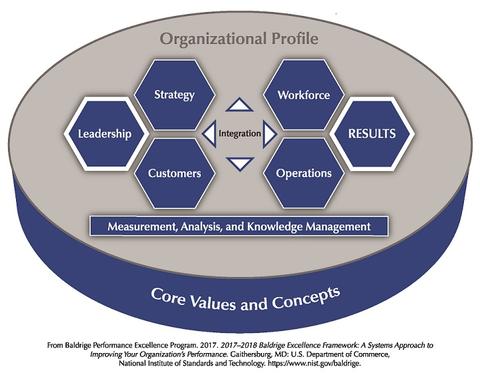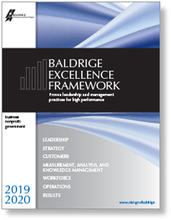Blogrige
The Official Baldrige Blog
Culture and Strategy Eat All Three Meals—When Leaders Set the Menu

Spring 2019
We have all heard the saying, “Culture eats strategy for breakfast,” a statement believed to have come from management guru Peter Drucker. The 2018 Baldrige Award recipients demonstrate that culture and strategy combined make for a full and healthy “meal plan” every day, especially when an organization’s leadership sets the environment that allows culture and strategy to thrive. To be clear, by thrive, I mean that strategy is planned, executed, and agile to enable an organization to adapt to change.
Each year when I return from the Baldrige Program’s annual Quest for Excellence® Conference (QE), I sift through my notes and look for themes that characterize what I have heard from multiple Baldrige Award recipients. I perform this analysis for two reasons. First, the themes point me in the direction of areas where I may want to review my own organization’s performance or adapt a best practice from the new award recipients. Second, sometimes the themes reveal an emerging area of importance to organizational performance broadly. This year, my experience was somewhat different. The themes pointed me in a more holistic direction through the combination of themes I noted. Specifically, I noted the importance of culture and strategy combined with visionary leadership as an integrated driver of organizational excellence. In regard to the Baldrige Excellence Framework, we frequently reference the concept of integration, the ability of an organization to function like a living organism, with all the parts operating in unison.
Of importance for the validation of this integrated driver, there are five 2018 Baldrige Award recipients from four different economic sectors: education, nonprofit, business, and health care. These organizations are Alamo Colleges District, Donor Alliance, Integrated Project Management Company, Inc. (IPM), Memorial Hospital and Health Care Center (MHHCC), and Tri County Tech (TCT). Their products and services are widely different, but their leadership’s integration of culture and strategy with operations have yielded spectacular outcomes.
Three Themes
While the importance of culture, strategy, and visionary leadership is not new, the observation of the three functioning together so well gave me new insight into the holistic systems perspective presented by the Baldrige Excellence Framework and how this holistic system can contribute to remarkable organizational performance.

I will cover the three topics separately in this publication, but many of the examples presented could have fit in more than one of the three categories. This realization is part of what led me to the conclusion about the integrated nature of the organizational excellence the 2018 Baldrige Award recipients achieved. Furthermore, I detected some clear sub-themes related to culture and visionary leadership. For culture, these sub-themes are that the five organizations are great places to work and that they pause to celebrate success in numerous ways. For visionary leadership, these sub-themes are effective communication, leadership by all, and building trust. And true to the theme of “integration,” these leadership sub-themes are part of the organizations’ culture.
CULTURE
All five organizations know and display daily the importance of their workforce as a key factor in their success. At MHHCC, the culture is defined by to “be” and to “act.” Workforce members are each there for their colleagues and their patients. They have a “no pass” zone, never passing anyone in the hallway without a greeting. MHHCC has a six-step leadership system. Step two is to create a culture of compassion and excellence. This culture is built on MHHCC’s core competency of cultivating collaboration. IPM defines four essential leadership responsibilities: inspiring culture, strategy, execution, and evolution. This simple statement from IPM demonstrates the holistic approach to the three themes I identified this year.
Furthermore, IPM’s vision to be “the best” is exemplified by excellence, ethical leadership, community involvement, and the highest commitment to our family (i.e. staff) members (emphasis is IPM’s). At Donor Alliance, People First is the “anchoring” core value. The organization has four strategic objectives; number two is “high-engagement culture.” At Tri County Tech, Mantra Two is “If you’re not taking care of the student, take care of someone who is.” That’s how you fit in at TCT! In TCT’s words, this makes the CEO a support staff member. In analogous fashion, Alamo Colleges District leaders believe in service over self and practice servant leadership.
Great Place to Work
Does the culture pay dividends in these five organizations? Certainly yes, as demonstrated by their workforce results. Here are some data from their employee engagement results:
- Alamo Colleges District exceeds the national norm in the Personal Assessment of the College Environment (PACE) survey for workforce overall climate scores, with two of the district colleges in the top 10% for overall climate.
- In 2018, Donor Alliance scored 90% (top decile) in employee engagement, steadily increasing from 79.9% in 2015.
- Employee recognition of IPM as a Great Place to Work (GPTW) stands at 94%, which is within 2% of the GPTW best-in-class benchmark.
- At MHHCC, the registered nurse (RN) turnover rate, a popular indicator of employee engagement, has remained below 2% since the first quarter of 2016, easily outperforming the national top decile level of 8%.
- Tri County Tech has been recognized as a GPTW for 2015–2018, with 96% of employees saying it is a great place to work.
Celebrating Success
Too often organizations focus only on opportunities for organizational and personal improvement and do not build on successes as great organizational and personal motivators. These five organizations focus on improvement and celebrating success. Following are a few examples of motivating the organization through celebrating success:
- Tri County Tech gives employee awards for demonstrating the organization’s values, and employees willingly give back, with 100% of employees donating to the Tri County Tech Foundation.
- MHHCC celebrates successes with “Really Impressive Moments” recognition programs.
- Giving back is a core principle at IPM. The organization and its people celebrate their community by supporting over 150 charities with time, talent, and financial support.
- At Donor Alliance, the CEO sends out 750 handwritten notes a year celebrating staff successes.
- Alamo Colleges District holds a monthly meeting to celebrate successes.
STRATEGY
Developing strategy and monitoring execution of the strategy is critical to the success of all organizations. These five organizations each have their own, different approach, but in all, the leadership takes responsibility (through the leadership system) and involves all key stakeholders. The Alamo Colleges District leadership cycle starts with establishing goals. The approach uses a BIG WIG (Wildly Important Goal) and creates a line of sight from the District’s vision (to be best in the nation in student success) to each of the colleges’ classrooms. The process starts by asking whether Alamo is student-ready, rather than asking if the student is college-ready. Being “ready” as a college has led to setting goals for student retention and employment for graduates. For example, with many of the organization’s students going hungry, a focus on studies was difficult. To retain such students, Alamo established a food pantry. This strategy has paid off with a 326% increase in the three-year graduation rate from 2006 to 2018.
Donor Alliance has a five-box leadership system that starts with the leadership and the board of directors setting direction. This is followed by developing strategies; aligning people, process, tools, and technology; deploying the plan; and finally, evaluating and improving. With a strategic mission impact goal of maximizing donations, the organization chartered a mission impact team, set action plans and metrics, and implemented the action plans. The result over the last five years has been a 47% increase in organ donors, a 45% increase in organs transplanted (compared to a national average of 25%), a 44% decrease in deaths of those on Colorado’s transplant waitlist, and a 43% increase in tissue available for implant.
To achieve IPM’s vision of profitable growth until its centennial and beyond (the company is currently 30 years old), strategy and execution are essential responsibilities for its leadership. IPM uses an OODA model for planning (Observe, Orient, Decide, and Act). It operates with a ten-year vision and a two-year plan. Measurement is critical, and strategic goal metrics are accessible anytime and reviewed quarterly. To ensure that strategy and operations are in sync, IPM also regularly reviews 17 key leading and lagging measures, manages the business metrics for regular management decisions, and monitors metrics that must at a minimum be stable over time. The results are a 70% increase in its growth rate since IPM started using the Baldrige framework. The organization is well on its way to 100 years—smartly scaling growth.
The MHHCC leadership system has six leadership requirements: set organization direction/ determine priorities; create a culture of compassion and excellence; engage the workforce; execute the plan; achieve results; and monitor performance. Every department at MHHCC has a copy of the organization’s one-page strategic plan for ready reference. Faced with a perfect storm that created a primary care physician (PCP) shortage in 2016, MHHCC started with a TOWS analysis (SWOT backwards) knowing that its external environment was where it had to look. The priority was clear. With a plan in place, a two-person nurse practitioner clinic was opened in early 2017, three additional PCPs were added in 2017, and for the long term MHHCC has engaged in a unique consortium with four competitor hospitals to collaborate with Indiana University on a family medicine residency program.
TCT’s work is defined by its Plan for Excellence, which is based on its mission, vision, values, and core competencies. TCT does annual strategic planning, all employees are involved, and progress is tracked through key performance measures. TCT follows two of its mantras when planning: “when you try to be everything to everybody, you can’t be anything to anybody” and “less is more, stick to the core.” Following these mantras and its plan, in 2005 TCT made the bold move of declining federal funding to focus on delivering the best education to its students. Sticking to the core, 90% of TCT’s Vision 2020 goals have been met. The organization has grown from serving 7,500 students to serving more than 23,000 in the fiscal year 2018, and it has been recognized as a top place to work by Fortune magazine.
VISIONARY LEADERSHIP
Four aspects of leadership were points of particular mention by all or many of the senior leaders of the 2018 Baldrige Award recipient organizations. The first is setting vision and direction, as described in the previous sections. The remaining three aspects are important because they are significant drivers of employee engagement and signs of high-performing organizations. The three aspects are communication, leadership by all, and ethics and trust.
Communication
Successful leaders are visible, transparent in their communication, and good listeners who respond to employee input and concerns. Sue Dunn of Donor Alliance, in addition to her 750 handwritten notes a year, holds staff meetings at all three sites, has multiple methods for listening to employees, and has been conducting executive rounding for 11 years. Rich Panico personally interviews all candidates for employment at IPM. He sends a birthday card with a personal note to every employee. Other communication mechanisms with the geographically distributed IPM staff include email messages, podcasts, a newsletter, face-to-face meetings, and a quarterly all-staff meeting bringing the whole “family” to one location. Lindel Fields makes a point of being visible among the TCT staff, holds monthly superintendent forums for two-way interaction, and has a weekly Facebook live update. He believes email almost always gives someone else work to do, so it should always include a “hello” and a “thank you.” At TCT if the email includes a “complaint,” it is held for 24 hours, reviewed, and then sent if still appropriate. Kyle Bennett of MHHCC does formal and informal rounding at all sites, sends a Friday email to all staff members that includes weekly “really impressive moments” as well as his personal cell phone number so anyone can contact him. Mike Flores of Alamo Colleges District meets weekly with all principals, does rounding at Alamo’s five sites, holds a morning huddle with leaders each day, and has a monthly meeting that includes celebrations.
Leadership by All
Leadership by all is evident in the cultures of the five organizations, as illustrated in the earlier section. With Alamo Colleges District’s commitment to student completion, not student enrollment, the Alamo Way is about “a leader in every seat.” As an example of listening, before starting as the official chancellor, Mike Flores (with board of directors’ agreement) spent six months listening to all the organization’s leaders. Leadership by All is one of the four values at TCT. It is brought home by the organization’s fifth mantra: “it is not what you do in a day, rather, what you do daily that matters.”
Ethics and Trust
I believe that trust in leadership and ethical behavior role-modeled by leaders are pre-requisites for a high-performing organization and among the key measures of senior leader performance. The focus on ethics and trust building in the five Baldrige Award-winning organizations this year was demonstrated throughout the QE presentations. To share a few of the data points I heard during the conference, Donor Alliance’s workforce has given a 95% favorable rating of its trust in senior leaders. TCT is in the top 10% nationally in the Great Places to Work survey for workforce perception of ethical leadership. And I found the most interesting commitment to ethical behavior conveyed by the leadership of IPM. To demonstrate its commitment to the IPM values, if a client breaches IPM’s ethical behavior principles, IPM will “fire” the client and donate the income from that client to charity. It is, therefore, no surprise that IPM scores 9.3 (on a ten-point scale) in workforce ratings demonstrating the belief that the company is managed in alignment with its mission and beliefs.
Two Gems
In addition to the powerful messages from the 2018 Baldrige Award recipients, here are two gems I heard from other leaders at the conference:
Benito Flores, chair of the board of ASQ, shared that research performed by the Mexican Quality Award examining its award recipients over time for correlations between performance in the six process categories in the Mexican Quality Award criteria and category 7, Results. Category 1, Leadership, correlated the best by far with the scores in category 7.
Gerry Agnes, president and CEO of Elevations Credit Union (a 2014 Baldrige Award recipient) shared that his personal measure of success is “Did I create a safe environment for our employees to contribute?” Did I create an environment of trust?
How Are You Leading Your Organization?
What culture are you creating or contributing to in your organization? Are you open and transparent in your communication? Are you celebrating success as well as looking at opportunities for improvement? Are you encouraging leadership by all members of your team? Are you approaching the future strategically? Are you creating an environment of trust?
Are you on the road to performance excellence?
Resources
Is Good, Good Enough for You? Taking the Next Step After ISO 9001:2015 (Winter 2018-2019)
Archived Columns
A Systems Approach to Improving Your Organization’s Performance

Baldrige Excellence Framework
The Baldrige Excellence Framework has empowered organizations to accomplish their missions, improve results, and become more competitive. It includes the Criteria for Performance Excellence, core values and concepts, and guidelines for evaluating your processes and results.
Purchase your copy today!
Available versions: Business/Nonprofit, Education, and Health Care





